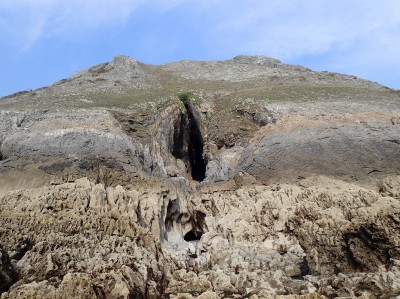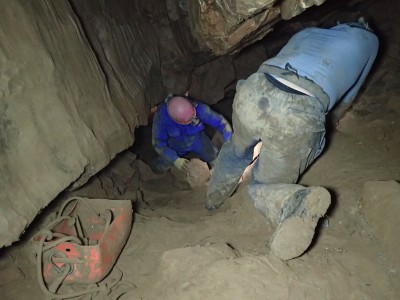27th-28th April: An away trip to the Gower for some of the Hallowe’en Team.


Looking down into Harry Thomas’s Cave from the entrance platform, Alex and Jon pictured.
is all about excursions in the countryside including caving and digging trips, walks and thoughts.
Simmonds, V. 2014. An overview of the archaeology of Mendip caves and karst. Mendip Cave Register & Archive (MCRA). (currently being revised, 2016)
An overview of the archaeology of Mendip caves and karst is freely available online at www.mendipgeoarch.net and in the archaeology section of the Mendip Cave Register & Archive at www.mcra.org.uk
27th-28th April: An away trip to the Gower for some of the Hallowe’en Team.


Looking down into Harry Thomas’s Cave from the entrance platform, Alex and Jon pictured.
7th April: A day trip to the Gower Peninsular with John Cooper and Danny McCarroll.


Minchin Hole, Gower
27th December 2018: with Roz, Brockers, Nick, Tav and Jon.
Had purchased some supplies and a good team assembled to help carry the equipment, including drill bag, sundries bag, drill-bit tube, wire and a 3.5m aluminium ladder, into the cave. There was some debate regarding the length of the ladder, so Brockers carried in a hacksaw, just in case. A careful trip through Chamber 20 to the sand dig where there was plenty of evidence for recent slumping.
With a bit of jiggling the ladder was installed and I was able to drill 4no. holes into the slab of rock. Brockers passing various bits of kit and stuff as and when required. The rest of the team spent time sorting out the spoil heap and ran-out the wire. The holes were charged, and the evening brought to a satisfactory conclusion from a safe location.
Hunter’s!
23rd December: Spur and furrow morphology at Sandy Bay, North Somerset.

The spurs comprise silts and clay with some sand, the base of the furrows being lined by a coarse pebble/fine cobble layer, which could be an underlying sediment or a lag deposit dragged into the furrows by the tide.
Swallow Cliff Bay drift sequence. The most complete exposure is found in the south-eastern corner of the bay (right-side of image) where it rests on the fossil shore platform, here it is cut into [Carboniferous] basaltic lava at about 12.5 m OD.

Reference: Case, D.J. 2013. The Coast of the Bristol Region: Quaternary Geology and Geomorphology. Geologists’ Association Guide No. 71
6th December 2018: With Duncan, Jonathon, Nick, Tav and Alex
The trip through Chamber 20 didn’t appear to be much wetter than last week, in spite of the recent rain. At the sand dig, the water level had risen c.150-200mm and was encroaching into the alcove. Everything at the bottom of the dig was slippery, the self-digging hadn’t occurred, and the large, precarious slab of rack was still overhead. After some protracted discussion, it was decided that the rock needs to be dealt with before digging can continue [relatively] safely, some chemical persuasion is required, it will be done!
Tav suggested that we might re-locate the retaining wall and so create extra spoil dumping space, this seemed a good idea so, that’s what we did for the evening.
I had a less than comfortable trip out of the cave, the sole of my boot had decided to become detached and go solo, one moccasin is not great for caving – or one socked foot either!
29th November 2018: Last weeks digging session was abandoned for the pub when only three of us turned up at Wookey Hole.
Better turn-out this week, with Nick, Tav, Jonathon, Duncan, Mike and, course yours truly, all keen and raring to go, unfortunately Roz got left behind and wasn’t happy about it!
After some persistent wet weather recently, we weren’t all that hopeful about this evening’s prospects but, we headed off anyway. The cave was active, the sound and sight of dripping, running water all the way up through Chamber 20. At the sand dig, the anticipated puddle of water but, rather surprisingly, not as deep as expected.

The excavation had become self-digging as more had slumped from the roof to reveal a space overhead, which was encouraging, and potential lead(s). Some digging was possible but continual slumping and a large, suspect slab overhead soon put an end to it. That was, until Nick decided to poke a bar into the bottom of a small pool of water that became a flow of water and a pile of sloppy sediment. After some more interventions, more slumps, and time running-out, we decided to leave it to settle down, perhaps continue to self-digging and return next week. hopefully, the water will continue to drain freely, and wet conditions will not impede further progress too much.
To the pub!
15th November 2018: with Jonathon, Mike, Nick and Alex
Surprisingly, the sand dig was dry and didn’t appear to have backed-up at all after the very heavy rain last weekend. However. A seepage of water through the sediments in the alcove had caused some slumping and work was concentrated there to tidy-up and consolidate. The trickle of water that enters from the chamber was constant, making the steps slippery so these were tidied up too, very sloppy spoil. The water from the trickle is draining freely through the sandy sediment at the bottom of the dig.
Alex and Nick shared the digging, Mike loaded the filled buckets into the skip, Jon hauled the skip up the slope and I emptied the buckets. The process was, of course, repeated many times.
8th November 2018: with Alex, Mike, Jonathon and Roz
It’s been raining recently and all the way up through Chamber 20 the results of this were clear; the drips were stronger, pools were filling-up and water was flowing down the calcite cascade. However, on arrival at the sand dig, we were pleasantly surprised to find it bone dry and no signs of water having flowed into it, this despite the small tube being full and overflowing.
Alex climbed down into the pit and began digging in the alcove, I was moving the filled buckets and passing them up to Mike, who then placed the filled buckets into the skip, hauled by Jonathon, Roz was in control of spoil dispersal. The empty buckets were returned, the process repeated, many times.

Alex reaches for the mattock
In between moving buckets, I spent a little bit of time tidying-up a section of the sediment bank where evidence of flooding and subsequent draining events is clear. It really needs more time spent on it and a full section cleaned and recorded.

Height of sediment sequence c.100mm
All too soon it was time to move the tools to higher ground, just in case, and depart the cave.
25th October 2018
With Alex, Nick, Jonathon, Mike, Duncan and David Walker (curator at the Wells & Mendip Museum and MCRA)
At the sand dig we were relieved to see it had dried-up and quite quickly after the fill event by the look of it. I started to dig in the [dry] alcove, because I got there first, Alex reduced a limestone boulder in size and removed the slop from the lowest point of the dig. The spoil management team were not impressed with the slop and were experiencing some difficulty in extricating it from the bucket. The solution, they decided, was to put a couple of handfuls of drier sediment into the bucket first, the diggers, of course, complied with this instruction.
Nick was on the steps passing the filled buckets to David, loading the skip to the spoil management team comprising Jon, Mike and Duncan.
When Alex had removed the slop, he turned his attention to clearing the loose sediment that I was creating in the alcove. The buckets started to move freely at a good constant rate. There are some very interesting layers of deposition to look at in the sediment bank, these can become, somewhat, of a distraction. Flood events and subsequent drying periods can be clearly distinguished.
All too soon it was time to stop digging, clear the loose, stash the tools at a safe height and make our way out of the cave. Changed in the car park and up to the Hunter’s for well-earned refreshments.
18th October 2018
With (l to r) Mike, Duncan, Nick and Tav
After persistent rain last weekend, it was not a surprise to find that the trip through Chamber 20 was wetter, the calcite cascade had water flowing down it. As suspected the sand dig was had about a metre of water at the bottom and there was still a trickle of water flowing into it, as such, it was undiggable. There were a few rocks in a vulnerable position, if a slump-in occurred they might end up at the bottom of the dig. So, these were moved and the spoil retaining wall was extended.

We were in the Hunter’s a bit earlier than usual. At least the forecast is for dry weather for the next few days, so the dig might drain. Unfortunately, it will not take much rain to refill it though.
11th October 2018
With Nick, Mike, Jonathon, Tav, Alex and Duncan
Nick, Mike and Jonathon at the sharp end, digging and filling buckets, then moving the filled buckets and occasional rocks to Tav who then facilitated dispatch. Alex hauling the loaded skip and passing buckets and rocks to Duncan. The buckets were emptied onto the spoil heap where I was on spoil management duties. It was a pleasant evening with the usual banter and a lot of sediment was shifted. The dig goes on!
We were joined, for a while by a large [queen] wasp. It was noted too, that the cave was slowly becoming wetter, previously dry pools now have water in them.
4th
October 2018
With Roz, Jonathon, Duncan and Mike
A mellow evening. Jon and Mike rotated the digging, Roz transferred the filled buckets to the skip, Duncan hauled the skip up the slope and I emptied the filled buckets. The procedure was repeated at a regular rate. A large rock was reduced in size, the pieces were added to the wall retaining the spoil.
The evening was concluded at the Hunter’s Lodge Inn in time honoured fashion.
27th September 2018
Duncan, Mike, Jonathon and Alex kept up the effort. Buckets were filled and emptied, rocks were removed.